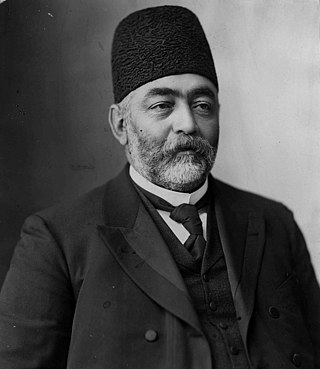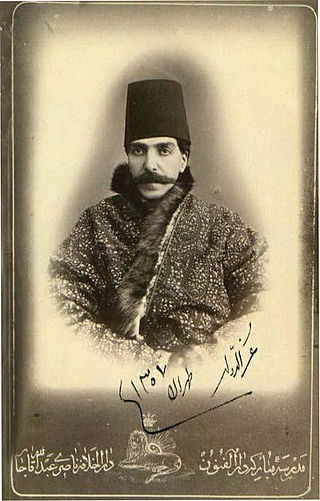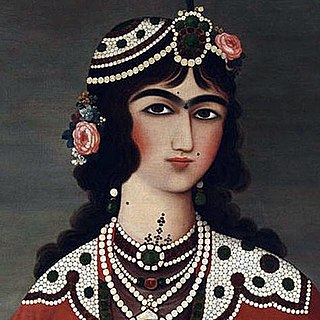This article needs additional citations for verification .(February 2024) |
| |||||
| Decades: | |||||
|---|---|---|---|---|---|
| See also: | Other events of 1861 Years in Iran | ||||
The following lists events that have happened in 1861 in the Qajar dynasty.
This article needs additional citations for verification .(February 2024) |
| |||||
| Decades: | |||||
|---|---|---|---|---|---|
| See also: | Other events of 1861 Years in Iran | ||||
The following lists events that have happened in 1861 in the Qajar dynasty.

The Golestan Palace, also transliterated as the Gulistan Palace and sometimes translated as the Rose Garden Palace from Persian language, was built in the 16th century, renovated in the 18th century and finally rebuilt in 1865. It is the former official royal Qajar complex in Tehran.

Mozaffar ad-Din Shah Qajar was the fifth Qajar shah of Iran, reigning from 1896 until his death in 1907. He is often credited with the creation of the Persian Constitution of 1906, which he approved of in one of his final acts as shah.

Naser al-Din Shah Qajar was the fourth Shah of Qajar Iran from 5 September 1848 to 1 May 1896 when he was assassinated. He was the son of Mohammad Shah Qajar and Malek Jahan Khanom and the third longest reigning monarch in Iranian history after Shapur II of the Sassanid dynasty and Tahmasp I of the Safavid dynasty. Naser al-Din Shah had sovereign power for close to 51 years.

Qajar art was the architecture, paintings, and other art forms produced under the Qajar dynasty, which lasted from 1781 to 1925 in Iran (Persia).

Mirza Ali Asghar Khan, also known by his honorific titles of Amin al-Soltan and Atabak, served as Prime Minister of Iran from 1887 to 1896 under Naser ed-Din Shah Qajar, from 1898 to 1904 under Mozaffar ed-Din Shah Qajar and from May 1907 until his assassination in August 1907 under Moahammad Ali Shah Qajar.

Kamran Mirza was a Qajar prince and third surviving son of Naser al-Din Shah Qajar. He was the brother of Mass'oud Mirza Zell-e Soltan and Mozaffar ad-Din Shah Qajar. Kamran Mirza also served as Iran's Commander-in-Chief, appointed in 1868 for the first time, and minister of war from 1880 to 1896 and from 1906 to 1907.

Abdosamad Mirza Ez od-Dowleh Saloor was a Persian prince of Qajar Dynasty and fifth son of Mohammad Shah Qajar by his wife Ogholbeigeh Khanum, a lady of Turkmen origin. He is the ancestor of Salour (Saloor) family.

Malek Jahan Khanom was the wife of Mohammad Shah Qajar and the mother of Naser al-Din Shah. She was the de facto regent of Iran for one month, from 5 September until 5 October in 1848, between the death of her husband and the accession of her son.
Naser al-Din Shah's slide was a slide in the subterranean baths of the Negarestan Palace in Tehran, Qajar Iran. The Encyclopedia Iranica notes that Western visitors commented on "the royal palace of Negārestān and salacious reports about its slide used for erotic purposes". The slide was destroyed by Reza Shah Pahlavi after he overthrew the Qajar dynasty.

Ali-Reza Khan Azod-ol-Molk was an Iranian politician who acted as regent for Ahmad Shah Qajar, the last ruling member of the Qajar dynasty.

Abu'l-Hasan Khan Ghaffari Kashani was an Iranian painter, miniature and lacquer artist, and book illustrator. When he became the Chief Court Painter, he also became known as Sani al-Mulk (صنیعالملک), meaning "The Crafter of the Kingdom." He was a student of Mihr 'Ali and a court painter in Mohammad Shah Qajar's court. After being dismissed as a court painter, he went to Europe to study, most notably in Italy. When he returned to Iran, he became the Director of Printing and Chief Illustrator for Naser al-Din Shah and earned the separate title Chief Court Painter. He supervised the illustration of a famous One Thousand and One Nights manuscript, which can be viewed today in Tehran in the Golestan Palace Library.
The following lists events that have happened in 1896 in the Qajar dynasty.
The following lists events that have happened in 1907 in the Qajar dynasty.

Nahāvand Castle was an ancient castle from Sasanian Persia that was located in what is now the city of Nahavand in Hamedan province, Iran. The fall of this castle in the Battle of Nahavand was a major turning point in the Islamic conquest of Persia. Nonetheless, the castle survived up until the time of Naser al-Din Shah Qajar. It was said that when digging a qanat, Naser al-Din Shah found a treasure. He then ordered the castle to be destroyed in order to find more treasures; however, no more were found.

The Nassereddin Shah relief known as Shekl Shah and Shekl-e Shah is a rock relief commissioned by Naser al-Din Shah Qajar around 1879, showing the shah on horseback flanked by ten standing ministers. It is the latest in a tradition of large rock reliefs ordered by Iranian rulers. It is located on the Haraz road overlooking the Haraz river about 60 km from Amol in Mazandaran Province, Iran. It is close to an ancient Sassanid road. The work was ordered after the new road was built in 1879.

Abu’l-Qāsem Khān Qarāgozlu, known by the title Nāṣer-al-molk, was an Iranian politician who served as Regent, Prime and Finance Minister of Iran during the Qajar dynasty.

Jeyran was one of the beloved wives and first mistress of Naser al-Din Shah Qajar.

The harem of the monarchs of the Qajar dynasty (1785-1925) consisted of several thousand people. The harem had a precise internal administration, based on the women's rank.
Ḥakīm Yazghel Ḥaqnaẓͅar was an Iranian Jewish court physician of Mohammad Shah Qajar and Naser al-Din Shah Qajar. He was on good terms with Naser al-Din Shah's mother Malek Jahan Khanom, and with Jeyran, one of Naser al-Din Shah's beloved wives and first mistress. Haqnazar's grandfather had come to the capital Tehran from Khansar in 1821 during the reign of Fath-Ali Shah Qajar. Haqnazar is credited with having founded the Hakim synagogue in the Jewish quarter of Tehran. His three brothers were also court physicians; his brother Hakim Musa, also served under Mohammad Shah and Naser al-Din Shah.
Mirza Mohammad Taqi Sepehr, also known as Mirza Mohammad Taqi Kashani, or with the honorific Lesan ol-Molk, was an Iranian court historian and littérateur of the Qajar era. He wrote with the pen name Sepehr, and is known for authoring the lengthy Persian chronicle Nasekh ol-tavarikh-e salatin-e Qajariyeh, also simply known as the Nasekh ol-tavarikh.